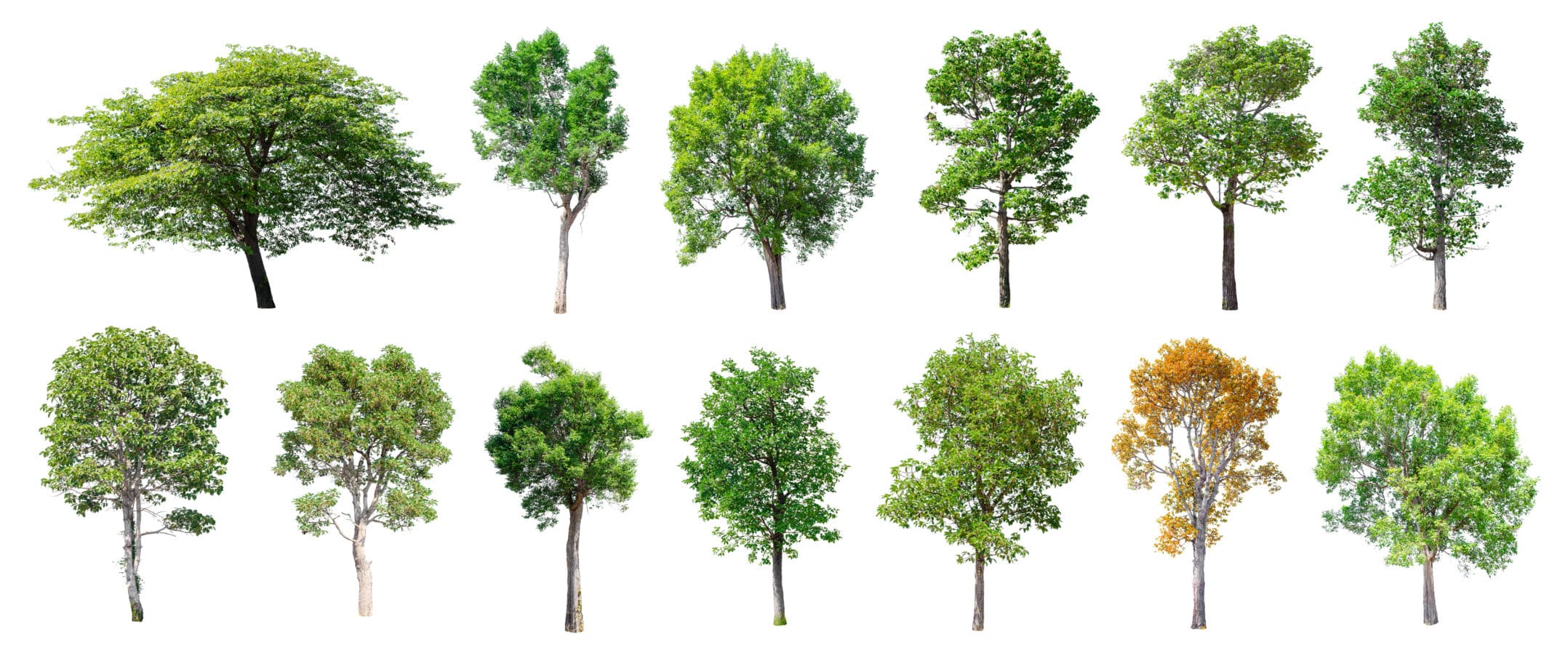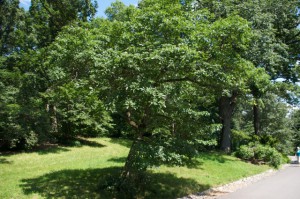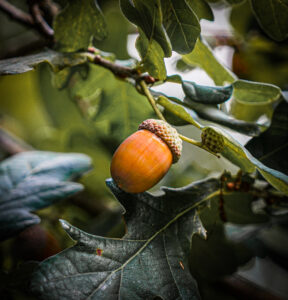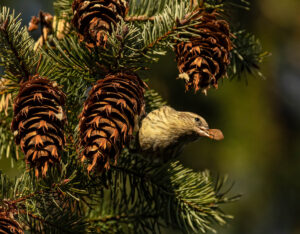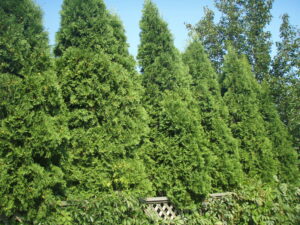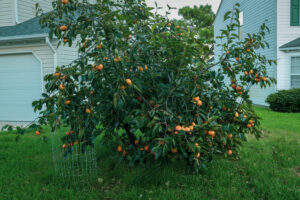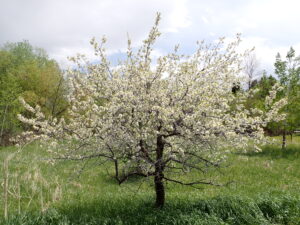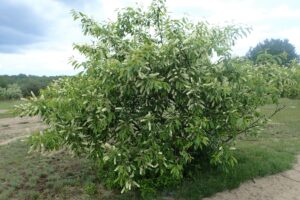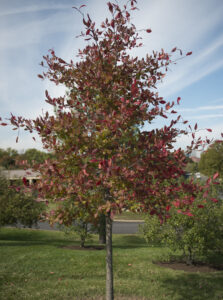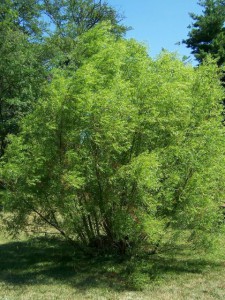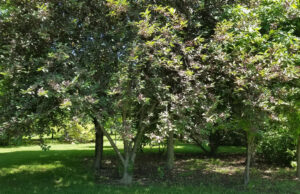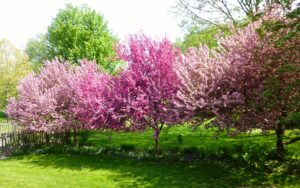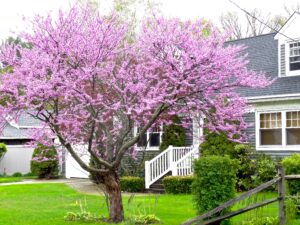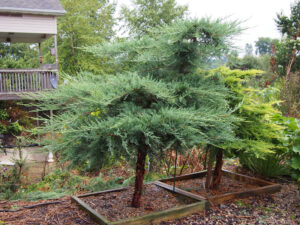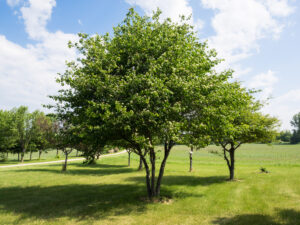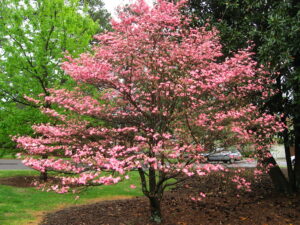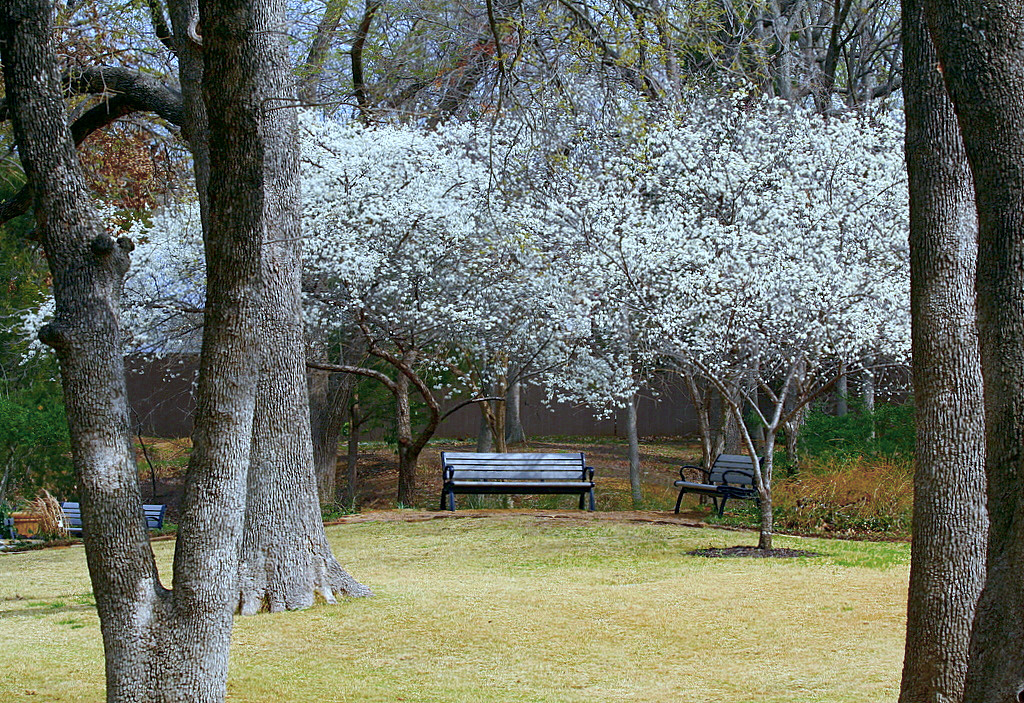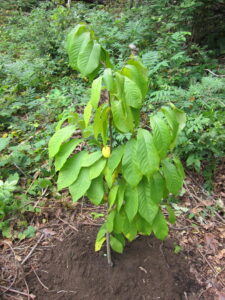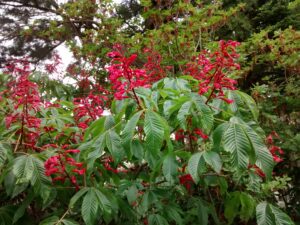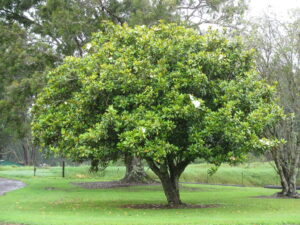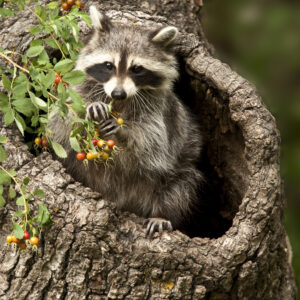The following trees are excellent for wildlife. Many may be species you haven’t thought about. Most are suited to small-ish yards, and the larger ones have smaller varieties that can be substituted. They all offer something for you, too: a pleasing shape, pretty foliage, brilliant blooms, or fruit for humans, as well as wildlife. If you like a species that isn’t “native” to your area, that doesn’t mean it won’t grow there if you’re in the right hardiness zone and habitat for it.
Scale down with oaks
You’ve heard the saying, “Mighty oaks from little acorns grow.” Well, guess what! It’s also true that petite oaks grow from little acorns! Don’t disregard oaks if you’re looking for a wildlife tree for a small yard. The Dwarf Chinkapin Oak, Quercus prinoides is only 13-20 feet (4–6 m) tall. Native to New Hampshire, south to the Florida panhandle, then west to southeast Nebraska, Kansas, and Oklahoma, it produces sweet acorns that are loved by wildlife. Another small oak is the Gambel, Quercus gambelii, a native of the Southwest. And there’s the California Scrub Oak, Quercus berberidifolia, a small, compact shrub that spreads and grows to 6 feet (1.8 m) tall. There are others, too, so check your local garden center; wherever you live, even in the desert Southwest, there’s a small oak you can plant for wildlife.
About oaks and acorns
Acorns, the nuts of oak trees, are particularly attractive to wildlife, including raccoons, deer, other mammals, and birds like jays and woodpeckers. They’re packed with protein, carbohydrates, fats, and minerals. Sometimes, jays, squirrels, and others hide or bury them for future use. Some buried acorns are never reclaimed and become trees. Native oak trees are most common in the eastern half of the U.S. but can be planted anywhere. The Desert Scrub Oak, Quercus turbinella, among others, will even tolerate desert-like conditions. Zones 3–10.
Pine trees
Seeds from pine cones are enjoyed by squirrels, bears, birds, and rodents for their taste and high nutritional value. And humans love them, too—think of the tasty pinenuts we enjoy in salads and other recipes, which are seeds from pinyon pine trees. U.S. pinyon species grow at 6,000 to 8,500 feet (1.8–2.6 km), so they aren’t suitable for most yards. But there are other pine species that will fit every yard size and every habitat, even arid regions. Zones 3–8, depending on species.
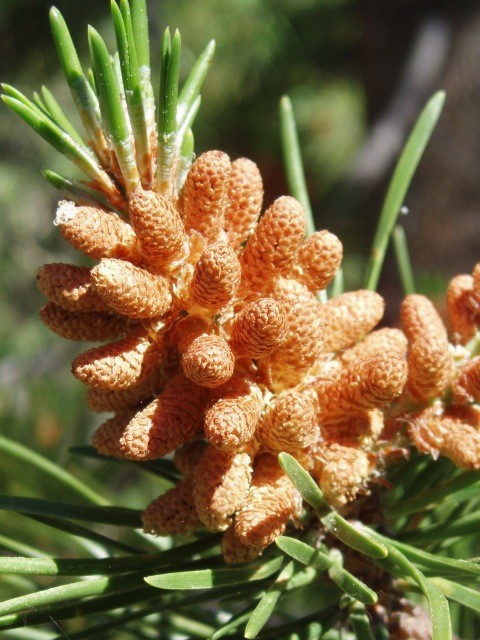
Male cone from Sierra Lodgepole Pine, Pinus contorta ssp. murrayana (M. Simmonson, USFS / Flickr; P.D.)
Pine cones
These are the parts of pine trees that contain the reproductive structures. They’re called cones because of their shape. Some are male, some female. Female cones contain ovules that are fertilized by the pollen from male cones. Seeds develop, and a protective woody covering (called scales) on female cones produces what we recognize as pinecones. Male cones are more inconspicuous.
Squirrels, birds, rodents, bears, and other wildlife eat pine cone seeds. For humans, other parts of pines are edible: pollen can be used as a flour substitute, high in protein, and needles make a tea that’s high in Vitamin C.
Junipers, Juniperus spp.
There are junipers in every size and for every habitat, so look for species that grow in your area. Your birds and other wildlife will appreciate it. Junipers are among the top ten trees for all wildlife, offering food and dense branches for protection from predators and winter’s chill. And, in spring, some birds hide their nests deep within the foliage. They may be the number one winter food source for American Robins. They perch all over them, like ornaments on a tree, eating every last berry (and getting drunk from any that fermented on the tree). Zones 3–9.
These berries that birds are so wild about aren’t truly berries. They’re actually fleshy versions of pinecones. Produced by female junipers, they contain seeds for new trees. The berries of some species are too bitter for humans; others, like that of the Common Juniper, Juniperus communis, can be used as spices and to flavor gin.
American Persimmon, Diospyros virginiana
This tree, also called Common Persimmon and Eastern Persimmon, is loved by birds, opossums, raccoons, and deer for its delicious fruit. A native tree of the eastern half of the U.S., it adapts to soil conditions from moist/well-drained to sandy. It grows from 30 to 80 feet (9–24 m) tall, so it’s best suited to a large yard. Plant both a male and female to ensure fruiting. It has fragrant flowers and takes about six years to begin producing, but it’s worth the wait. Fruit ripens in fall to early winter. Zones: 5–9.
The genus name for the American Persimmon, Diospyros, means “Fruit of the Gods.” Humans can enjoy persimmon fruit but don’t eat them until they’re fully ripe—until then, they’re mouth-puckering tart. NatureServe.org calls this tree critically imperiled in Connecticut and Iowa and imperiled in New York, so pamper it as something special.
American Plum, Prunus Americana
Also called Wild Plum, this tree is found in most of the U.S. There are many plum species offering various colors of fruit, growth habits, and appearance. Related to cherry, apricot, and peach trees, they’re loved by butterflies, honeybees, birds, and mammals for their nectar and fruit. Various butterflies also use them as hosts for their caterpillars. A small tree, it grows to only 15 feet (4.6 m) tall. It grows from Idaho south to New Mexico and east to Maine and Florida. Zones: 3–8.
Black Cherry, Prunus serotina
This is the most important native cherry tree in the U.S. because its fruit is eaten by thirty-three species of birds, plus opossums, raccoons, foxes, squirrels, and others. Humans, too: it makes good jam, pies, and wine. It, or one of its varieties, can be found over most of the U.S. except the most arid areas. It ranges from 49 to 79 feet (5–24 m) tall. Berries, which are produced in early summer, turn from red to black in August to October. Dropped fruit can be a nuisance, so plant it where that won’t matter. Zones 3–0.
Blackgum, Nyssa sylvatica
This tree grows only 1 to 2 feet (30–61 cm) a year but eventually reaches 66 to 82 feet (20–25 m), so this one needs space. It’s native to the eastern U.S. but will grow in the Midwest and Northwest, also. Wildlife love it—honeybees for the nectar and birds and mammals for the fruit. Humans appreciate it, too: its fall foliage in shades of yellow, scarlet, purple, and red is a visual delight. It wants well-drained soil and will tolerate part shade. Zones 3–9.
Willows, Salix spp.
Willows offer significant wildlife value due to their diverse habitats and growing conditions, and range of sizes. They’re highly valued by wildlife for their abundant foliage, which provides cover, nesting sites, and food sources. Many birds, such as warblers, thrushes, and woodpeckers, rely on willows for nesting. They also support a diverse array of insect life, serving as a food source for caterpillars, beetles, and other invertebrates, which in turn attract insectivorous birds and bats.
Moreover, willows are known for their graceful appearance. They have long, slender branches and delicate foliage that add beauty and visual interest to urban landscapes. One species or another can be grown just about anywhere in the U.S., even in arid locations.
Chokecherry, Prunus virginiana
Native to N.A. and found throughout most of the U.S., Chokecherry grows 20–30 (6–9 m) tall. It’s a good understory tree for shady spots, has showy blooms, and, if used as a shrub, will often form thickets that can serve as a boundary or screen in your yard. It’s safe for humans to eat the berries once they ripen (turn black ) and to make jam. Please don’t use the leaves or seeds, as they contain cyanide. Bees, birds, deer, and other animals use all parts of the tree: its blooms, fruits, leaves, and twigs. And it’s a host for the pretty Red-spotted Purple Butterfly. This species is not the same as Chokeberry, Aronia spp. It tolerates all soil types, moist to dry. Zones 2–7.
Crabapple Trees, Malus spp.
Plant a crabapple for wildlife and humans alike. They’re nicely shaped and produce lovely spring flowers for a visual treat. Bees use them for nectar and pollen—vital because crabapples don’t self-pollinate. At least 256 species of butterflies and moths use them as hosts. Birds use them for nesting and shelter. Squirrels, chipmunks, robins, mockingbirds, deer, and others eat their fruit. There are dozens of native crabapple trees, as well as cultivars. When deciding, select for disease resistance and the ripening time of the fruit, as it varies. The fruit is sour, best cooked and sweetened for jelly, preserves, chutney, bread, and wine. Zones 3–8.
Ever wondered about the difference between crabapples and apples? Crabapples are defined as having fruits 2 inches (50 mm) or smaller in diameter, and apples are anything larger than that.
Eastern Redbud, Cercis canadensis
You can’t go wrong with this little tree. Native to the eastern half of the U.S., it’s only 20 to 30 feet (6–9 m) tall and wide. Insects, including butterflies and bees, love the nectar in the showy spring flowers (humans can enjoy them, too, in salads or fried.) Its seeds are eaten by cardinals, Rose-breasted Grosbeaks, quail, and deer, among others. It’s a larval host for the Io Moth. It can flourish in full sun but really prefers partial shade, making it a good understory tree. Zones 4-9.
Eastern Redcedar, Juniperus virginiana
This tree isn’t a cedar, but a native juniper, an evergreen of the eastern U.S. and southeastern Canada. It’s good for cover, roosting, and food—more than forty species of birds eat the fruit! Because they’re among the first trees to repopulate cleared land, it’s often considered invasive. It also out-competes other tree species. But, if you have the space, it’s a yard tree that’ll have birds singing with joy! It’s also a host for Juniper Hairstreak Butterflies. To get fruit, plant a male and a female. It can be a host of cedar-apple rust, a fungus that spreads to apple trees, so keep it away from apple and crabapple trees. Allow room: it’s slow-growing but can rise 16–66 feet (5–20 m) high, depending on soil conditions. Zones 2–9.
Washington Hawthorn, Crataegus phaenopyrum
The Washington Hawthorn is primarily found in the eastern U.S. Its height and spread typically reach 20 to 35 feet (6–11 m), making it an excellent choice for urban yards. It thrives in various soil types and tolerates drought and pollution. Clusters of white flowers in spring are followed by bright red berries that persist into winter, providing a valuable food source for birds and other wildlife. Its dense foliage also offers nesting sites and shelter for birds. Zones 4–8.
Flowering Dogwood, Cornus Florida
A lovely tree native to the central and eastern U.S. and Canada, it presents showy flowers in April and May. Its high-fat fruit attracts birds and mammals, including deer, from September to December. This tree depends on bees, butterflies, and beetles for pollination and is susceptible to fungus. It grows 15 to 30 feet (5–9 m) tall. Plant it where it gets good airflow, morning sun, and partial shade. It likes rich, moist, but well-drained soil. Zone 5-9.
Mexican Plum, Prunus mexicana
A fast grower that produces fruit within its first three to four years, this tree is medium-sized, 15 to 35 feet (5–11 m) tall. It produces fragrant, showy, white flowers, and the late-summer fruit is eaten by birds, mammals, and humans. It can also be made into preserves. Drought-tolerant, non-suckering, it’s suitable for any yard. Ranges from South Dakota south and east to the East Coast. Zones 7–9.
Pawpaw, Asimina triloba
Native to the eastern U.S. and Ontario, Canada, there are eight species of pawpaws. They have a somewhat tropical look that’ll add interest to your yard, and they’ll take sun or shade, making good understory trees. Their flowers smell awful, but the berries are large, edible, and full of minerals, vitamins, and more protein than most fruits—no wonder songbirds, squirrels, raccoons, opossums, and foxes love them. They like hot summers and cold winters, so if your yard can offer that, they’re for you. Fertile, moist, well-drained soil will suit their other needs. Zones 6-8.
Red Buckeye, Aesculus pavia
One of seven native buckeye species, Red Buckeyes are native to North Carolina, south to northern Florida, west to central Texas, and north to southern Illinois and Quebec, Canada. However, the various species of buckeyes will grow about anywhere. This one is good for a small yard—no more than 25 feet (8 m) tall. Hummingbirds visit the flowers, and squirrels eat the seeds. All parts of the tree contain toxins, so it’s unsuitable for yards near beehives or where small children and pets are likely to sample the seeds. They tolerate shade and can be used for understory but are best in full sun. They green up early in spring but are among the first to lose their leaves in the fall. Zones 5-9.
Southern Magnolia, Magnolia grandiflora
This is a native of Maryland, south to Florida, and west to Texas. Its woody fruit ripens in early fall, and the high-fat seeds are eagerly eaten by birds, squirrels, opossums, quail, turkey, and others. It’s very large, up to 80 feet tall (25 m) and 30 feet (9 m) wide, but some cultivars are smaller, cold hardy, and can be grown as far north as southern Ohio, northern New Jersey, Long Island, and on the Pacific Coast to Vancouver, BC.
There’s hardly a tree more beautiful than a Southern Magnolia in bloom, with fragrant flowers up to 12 inches (30 cm) wide. Zones 7–10, depending on species.
Additional information
Snags
Snags are dead trees that are still standing. Birds, bats, squirrels, raccoons, opossums, among others, nest and roost in dead tree hollows. They attract insects, mosses, lichen, and fungi—a veritable smorgasbord for wildlife. High limbs provide handy look-outs for wildlife seeking prey. Hollows, nooks, and crannies are used to store food. Snags benefit more than 1,000 species in the U.S. Once they fall, they’re “logs.” Unless a snag threatens to damage something important, if it falls, leave it to benefit wildlife.
What gives trees their vibrant fall colors?
Autumn is a beautiful time of year, especially if there’s a long period of warm days, crisp nights, and colorful leaves. Several factors bring about the annual change in leaf color that presents such a visual delight. The most constant factor is fewer hours of sunlight. A green pigment, chlorophyll, responds to this by slowing down production, then stops altogether. Chlorophyll, all along, has been masking yellow pigments, which can now be seen. Simultaneously, a red pigment kicks into production. In Europe, fall leaves are more in the yellow range. In the U.S., there are more reds. While yellow pigments have always been there, red pigments are entirely new, and scientists aren’t sure why trees expend energy on producing new pigments when they’re about to shed their leaves.


